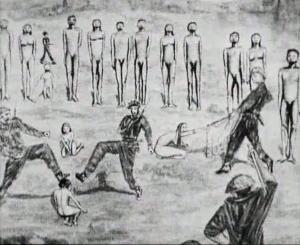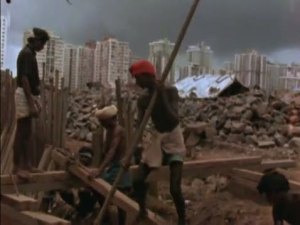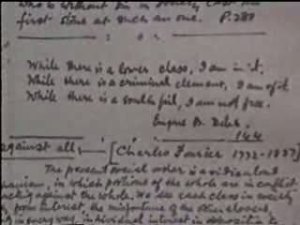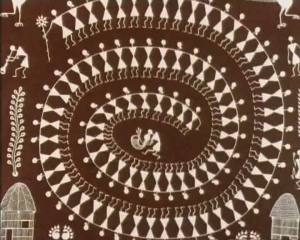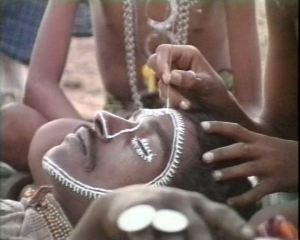Statement by Dr.B.R.Ambedkar on Gandhi’s Fast
(Statement on Mr.Gandhi’s attitude at the Round Table Conference towards the untouchables and their demand for Constitutional Safeguards, 19th September 1932.)I need hardly say that I was astounded to read the correspondence between Mahatma Gandhi, Sir Samuel Hoare and the Prime Minister, which was published recently in the Papers, in which he has expressed his determination to starve himself unto death till the British Government of its own accord or under pressure of public opinion revise their opinion and withdraw their scheme of communal representation for the Depressed Classes. The unenviable position, in which I have been placed by the Mahatma’s vow of self-immolation, can easily be imagined.
It passes my comprehension why Mr. Gandhi should stake his life on an issue arising out of the communal question which he, at the Round Table Conference, said was one of a comparatively small importance. Indeed, to adopt the language of those of Mr. Gandhi’s way of thinking, the communal question was only an appendix to the book of India’s constitution and not the main chapter. It would have been justifiable, if Mr.Gandhi had resorted to this extreme step for obtaining independence for the country on which he was so insistent all through the R.T.C. debates. It is also a painful surprise that Mr.Gandhi should single out special representation for the Depressed Classes in the Communal Award as an excuse for his self-immolation. Separate electorates are granted not only to the Depressed Classes, but to the Indian Christians, Anglo-Indians, Europeans, as well as the Mohammedans and the Sikhs. Also separate Electorates are granted to landlords, labourers and traders. Mr. Gandhi had declared his opposition to the special representation of every other class and creed except the Mohamedans and the Sikhs. All the same, Mr. Gandhi chooses to let everybody else except the Depressed Classes retain the special electorates given to them.
The fears expressed by Mr.Gandhi about the consequences of the arrangements for the representation of the Depressed Classes are, in my opinion, purely imaginary. If the nation is not going to be split up by separate electorates to the Mohamedans and the Sikhs, the Hindu society cannot be said to be split up if the Depressed classes are given separate electorates. His conscience is not aroused if the nation is split by the arrangements of special electorates for classes and communities other than the Depressed Classes.
I am sure many have felt that if there was any class which deserved to be given special political rights in order to protect itself against the tyranny of the majority under the Swaraj constitution it was the depressed classes. Here is a class which is undoubtedly not in a position to sustain itself in the struggle for existence. The religion to which they are tied, instead of providing for them an honourable place, brands them as lepers, not fit for ordinary intercourse. Economically, it is a class entirely dependent upon the high-caste Hindus for earning its daily bread with no independent way of living open to it. All ways are not closed by reason of the social prejudices of the Hindus but there is a definite attempt all through out the Hindu society to bolt every possible door so as not to allow the Depressed Classes any opportunity to rise in the scale of life. Indeed it would not be an exaggeration to say that in every village the caste Hindus, however divided among themselves, are always in a standing conspiracy to put down in a merciless manner any attempt on the part of the Depressed Classes who form a small and scattered body of an ordinary Indian citizen.
In these circumstances, it would be granted by all fair-minded persons that as the only path for a community so handicapped to succeed in the struggle for life against organized tyranny, some share of political power in order that it may protect itself is a paramount necessity.
I should have thought that a well-wisher of the Depressed Classes would have fought tooth and nail for securing to them as much political power as might be possible in the new Constitution. But the Mahatma’s ways of thinking are strange and are certainly beyond my comprehension. He not only does not endeavour to augment the scanty political power which the Depressed Classes have got under the communal award, but on the contrary he has staked his very life in order to deprive them of little they have got. This is not the first attempt on the part of the Mahatma to completely dish the Depressed Classes out of political existence. Long before, there was the Minorities pact. The Mahatma tried to enter into an agreement with the Muslims and the Congress. He offered to the Muslims all the fourteen claims which they had put forth on their behalf, and in return asked them to join with him in resisting the claims for social representation made by me on behalf of the Depressed Classes.
It must be said to the credit of the Muslim Delegates, that they refused to be a party to such a black act, and saved the Depressed Class from what might as well have developed into a calamity for them as a result of the combined opposition of the Mohammedans and Mr.Gandhi.
I am unable to understand the ground of hostility of Mr.Gandhi to the Communal Award. He says that the Communal Award has separated the Depressed Classes from the Hindu Community. On the other hand, Mr.Moonje, a much stronger protagonist of the Hindu case and a militant advocate of its interests, takes a totally different view of the matter. In the speeches which he has been delivering since his arrival from London, Dr.Moonje has been insisting that the Communal Award does not create any separation between the Depressed Classes and the Hindus. Indeed, he has been boasting that he has defeated me in my attempt to politically separate the Depressed Class from the Hindus. I am sure that Dr.Moonje is right in his interpretation of the Communal Award although, I am not sure that the credit of it can legitimately go to Mr.Moonje. It is therefore surprising that Mahatma Gandhi who is a nationalist and not known to be a communalist should read the Communal Award, in so far as it relates to the Depressed Classes, in a manner quite contrary to that of a communalist like Mr.Moonje. If Dr.Moonje does not sense any separation of the Depressed Classes from the Hindus in the Communal Award the Mahatma ought to feel quite satisfied on that score.
In my opinion, that Communal Award should not only satisfy the Hindus, but also satisfy those individuals among the Depressed Classes such as Rao Bahadur Rajah, Mr.Baloo or Mr.Gavai, who are in favour of Joint Electorates. Mr.Rajah’s fulminations in the Assembly have amused me considerably. An intense supporter of Separate Electorates and the bitterest and the most vehement critic of caste Hindu tyranny, now professes faith in the Joint Electorates and love for the Hindus! How much of that is due to his natural desire to resuscitate himself from the oblivion in which he was cast by his being kept out of the Round Table Conference and how much of it is to his honest change of faith, I do not propose to discuss.
The points on which Mr.Rajah is harping by way of criticism on the Communal Award are two: One is that the Depressed Classes have gained lesser number of seats than they are entitled to on the population basis, and the other is that the Depressed Classes have been separated from the Hindu fold.
I agree in his first grievance, but when the Rao Bahadur begins to accuse those who represented the Depressed Classes at the R.T.C. for having sold their rights, I am bound to point out what Mr.Rajah did as a member of the Indian Central Committee. In that committee’s report, the Depressed Classes were given in Madras 10 seats out of 150; in Bombay 8 seats out of 14; in Bengal 8 seats our of 200; in U.P. 8 seats our of 182; in the Punjab 6 seats out of 150; in Bihar and Orissa 6 out of 150; in C.P. 8 out of 125; and in Assam 9 seats for the Depressed Classes and the indigenous and primitive races out of 75. I do not wish to overburden this statement by pointing out how this distribution compares with the population ratio. But there can be no doubt that this meant a terrible under-representation of the Depressed Classes. To this distribution of seats Mr.Rajah was a party. Surely, Mr.Rajah, before he criticizes the Communal Award and accuses others, should refresh his memory of what he accepted as Member of the Indian Central Committee on behalf of the Depressed Classes without any protest. If the population ratio of representation was to him a natural right of Depressed Classes and its full realization was to him a necessity for their protection, why did not Mr.Rajah insist upon it in the Central Committee when he had the opportunity to do so?
As to his contention that in the Communal Award, the Depressed Classes have been separated from the Hindus, it is a view to which I cannot subscribe. If Mr. Rajah has any conscientious objection to separate electorates, there is no compulsion on him to stand as a candidate in the Separate Electorates. The opportunity to stand as a candidate in the general electorate as well as the right to vote in it are there, and Mr.Rajah is free to avail himself of the same. Mr.Rajah is crying at the top of his voice to assure to the Depressed Classes that there is a complete change of heart on the part of the Caste Hindus towards the Depressed Classses. He will have the opportunity to prove that fact to the satisfaction of the Depressed Class, who are not prepared to take his word by getting himself elected in the general constituency. The Hindus who profess love and sympathy for the Depressed Classes, will have also an opportunity to prove their bona fides by electing Mr.Rajah to the legislature.
The Communal Award, therefore, in my opinion, satisfied both those who want separate Electorates and those who want joint electorates. In this sense, it is already a compromise and should be accepted as it is. As to the Mahatma, I do not know what he wants. It is assumed that although Mahatma Gandhi is opposed to the system of separate electorates, he is not opposed to the system of Joint electorates and Reserved Seats, That is a gross error. Whatever his views are today, while in London he was totally opposed to any system of Social representation for the Depressed Classes whether by Joint electorates or by Separate Electorates. Beyond the right to vote in a general electorate based upon Adult suffrage, he was not prepared to concede anything to the Depressed Classes by way of securing their representation in the legislatures. This was the position he had taken at first. Towards the end of R.T.C. he suggested to me a scheme, which he said, he was prepared to consider. The scheme was purely conventional without any constitutional sanction behind it and without any single seat being reserved for the Depressed Classes in the electoral law.
The scheme was as follows:
Depressed Class candidates might stand in the general electorate as against other high caste Hindu candidates. If any Depressed Class Candidate was defeated in the Election, he should file an election petition and obtain the verdict that he was defeated because he was an untouchable. If such a decision was obtained, the Mahatma said he would undertake to induce some Hindu members to resign and thus create a vacancy. There would be then another election in which the defeated Depressed Class candidate or any other Depressed Class candidate might again try his luck as against the Hindu candidates. Should he be defeated again, he should get similar verdict that he was defeated because he was an untouchable and so on ad infinitum. I am disclosing these facts as some people are even now under the impression that the Joint Electorates and Reserved Seats would satisfy the conscience of the Mahatma. This will show why I insist that there is no use discussing the question until the actual proposals of the Mahatma are put forth.
I must, however, point out that I cannot accept the assurances of the Mahatma that he and his Congress will do the needful. I cannot leave so important a question as the protection of my people to conventions and understandings. The Mahatma is not an immortal person, and the Congress, assuming it is not a malevolent force, is not to have an abiding existence. There have been many Mahatmas in India whose sole object was to remove untouchability and to elevate and absorb the Depressed Classes, but every one of them has failed in his mission. Mahatmas have come and Mahatmas have gone but the untouchables have remained as untouchables.
I have enough experience of the pace of Reform and the faith of Hindu reformers in the conflicts that have taken place at Mahad and Nasik, to say that no well-wisher of the Depressed Classes will ever consent to allow the uplift of the Depressed Classes to rest upon such treacherous shoulders. Reformers who in moments of crises prefer to sacrifice their principles rather than hurt the feelings of their kindred can be of no use to the Depressed Classes.
I am therefore bound to insist upon a statutory guarantee for the protection of my people. If Mr.Gandhi wishes to have the Communal Award altered, it is for him to put forth his proposals and to prove that they give a better guarantee than has been given to us under the Award.
I hope that the Mahatma will desist from carrying out the extreme step contemplated by him. We mean no harm to the Hindu Society, when we demand separate electorates. If we choose separate electorates, we do so in order to avoid the total dependence on the sweet will of the caste Hindus in matters affecting our destiny. Like the mahatma we can claim our right to err, and we expect him not to deprive us of that right. His determination to fast himself unto death is worthy of a far better cause. I could have understood the propriety of the Mahatma contemplating such extreme step for stopping riots between Hindus and Mohammedans or between the Depressed Classes and the Hindus or any other national cause. It certainly cannot improve the lot of the Depressed Classes. Whether he knows it or not, the Mahatma’s act will result in nothing but terrorism by his followers against the Depressed Classes all over the country.
Coercion of this sort will not win the Depressed Classes to the Hindu fold if they are determined to go out. And if the Mahatma chooses to ask the Depressed Classes to make a choice between Hindu faith and possession of political power, I am quite sure that the Depressed Classes will choose political power and save the Mahatma from self-immolation. If Mr. Gandhi coolly reflects on the consequences of his act, I very much doubt whether he will find this victory worth having. It is still more important to note that the Mahatma is releasing reactionary and uncontrollable forces, and is fostering the spirit of hatred between the Hindu Community and the Depressed Classes by resorting to this method and thereby widening the gulf between the two. When I opposed Mr. Gandhi at the R.T.C there was a hue and cry against me in the country and there was a conspiracy in the so-called nationalist press to represent me as a traitor to the nationalist cause, to suppress correspondence coming from my side and to boost the propaganda against my party by publishing exaggerated reports of meetings and conferences, many of which were never held. “Silver bullets” were freely used for creating divisions in the ranks of the Depressed Classes. There have also been a few clashes ending in violence.
If the Mahatma does not want all this to be repeated on a larger scale, let him, for God’s sake, reconsider his decision and avert the disastrous consequences. I believe the Mahatma does not want this. But if he does not desist, in spite of his wishes these consequences are sure to follow as night follows the day.
Before concluding this statement, I desire to assure the public that although I am entitled to say that I regard the matter as closed, I am prepared to consider the proposals of the Mahatma. I however trust the Mahatma will not drive me to the necessity of making a choice between his life and the rights of my people. For I can never consent to deliver my people bound hand and foot to the Caste Hindus for generations to come.
Dr.B.R.Ambedkar



